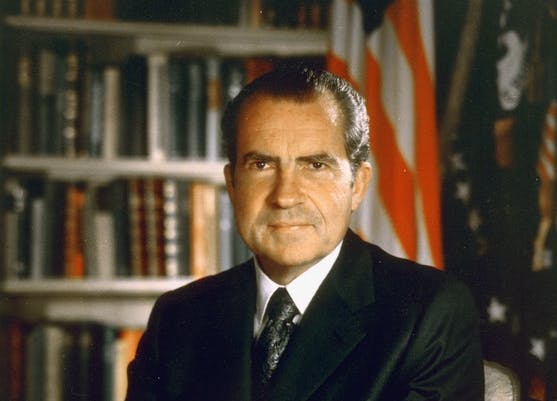Five Percent Inflation
Lest one suppose that five percent inflation is no big deal, look at the numbers leading up to August 15, 1971, when President Nixon slammed shut the gold window and ushered in the age of stagflation.

The slowdown in the pace of inflation — to five percent from the six percent reported last month — is a moment to revisit what triggered the collapse of the global monetary system that had been erected in the closing months of World War II. We speak of Bretton Woods, under which America had undertaken to redeem at a 35th of an ounce of gold per dollar greenbacks presented to our Treasury by foreign governments.
Lest one suppose that five percent inflation is no big deal, take a look at the numbers leading up to August 15, 1971, when President Nixon slammed shut the gold window in what became known as the Nixon Shock. What the numbers — we’re citing cpiinflationcalculator.com — show is that in August 1971 inflation was running at a yearly rate of 4.6 percent. The monthly inflation rate that year was 0.2 percent.
So we’re just saying: Don’t talk to The New York Sun about how five percent inflation is nothing to write home about. America threw over the whole postwar monetary system over less inflation than we’re running at the moment, which is down from the 9.1 percent at which it peaked in June 2022. Plus, too, that’s just CPI inflation. Feature the collapse of the dollar against the classical basis of monetary value: gold.
The breathtaking fact is that since 1971, the dollar has shed more than 98 percent of its value in ounces of gold. The markets are now valuing a one-dollar Federal Reserve Note at less than a 2,000th of an ounce of gold, mere vapor compared to the 35th of an ounce of gold at which it was defined in the Bretton Woods agreements. It amounts to a vote of no-confidence in the fiat dollars issued by the Fed.
Yet in 1971, Nixon downplayed the abandonment of America’s commitments under Bretton Woods, saying merely that he had directed his Treasury Secretary “to suspend temporarily the convertibility of the dollar into gold.” His avowed goal was to “protect the position of the American dollar as a pillar of monetary stability around the world.” He suggested the move would help “break the back of inflation.”
The New York Times fell for it hook, line, and sinker, suggesting in an editorial that Nixon was “rescuing the dollar.” The Times’ editors cheered Nixon on, “despite the shock” he caused by severing the dollar’s historic link to specie. The Times saw “his decision to suspend gold payments and to let the dollar find its proper exchange rate” as “basically a decision to work for the preservation of liberal trade.”
The Times, along with many others at the time, failed to see that Nixon had chosen the easy way out — defaulting on America’s promise to maintain the dollar’s value in gold instead of fighting inflation honestly, by way of spending cuts, deregulation, and lower taxes. In the event, Nixon’s plan failed. Between 1971 and 1980, the average annual pace of inflation was 7.9 percent, while growth was flat. It was the age of “stagflation.”
It took the efforts of Paul Volcker at the Fed, and President Reagan at the White House, to impose the discipline needed to beat inflation. Which brings us back to the misguided relief that inflation has come “down.” Economists and Fed watchers today seem all too ready to end the war on inflation and abandon the Fed’s two percent inflation target. Some are arguing for a four percent goal. What’s to stop them from declaring victory at five percent?

